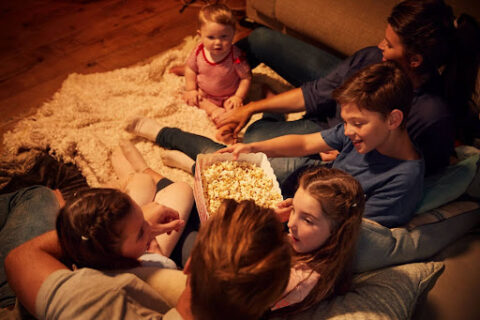Preparing Kids for a Move: Laying the Foundation
The first step in a stress-free move with children is preparation. Discuss the move with your kids, focus on the positives and address any concerns they might have. This open communication is key to helping them feel involved and reassured.

Packing Tips for Families: Make it a Team Effort
Packing can be one of the most daunting tasks when moving with children (or just moving in general). Here’s how to make it more manageable:
1. Involve Your Kids
Assign age-appropriate packing tasks to your children. This not only helps lighten the load but also makes them feel like an important part of the moving process. Here are some age-appropriate packing tasks for children of different age groups:
Toddlers and Preschoolers
- Sorting and Packing Toys: Allow them to choose which toys they want to take with them in a “special box.” This can make them feel involved and excited about the move.
- Sticker Labeling: Give them stickers to decorate and label their boxes. It’s a simple task that can keep them engaged and add a personal touch to their belongings.
School-Age Children (6-12 years)
- Packing Their Room: Children in this age group can start packing non-breakable items in their room, like stuffed animals, books and clothes.
- Creating an Inventory: They can help make a list or draw pictures of the items they have packed. This helps them learn organizational skills and ensures they remember where their possessions are.
- Decorating Boxes: Provide markers, stickers or colored tape for them to creatively label and decorate their boxes, making it easier to identify their belongings in the new home.
Teenagers
- Packing Their Personal Items: Encourage teenagers to take responsibility for packing their own room, including clothes, books and personal belongings.
- Assisting with Electronics: Older kids can be responsible for safely packing and labeling electronic devices, chargers and cables.
- Documenting the Process: If they are interested, teens can document the moving process through photos or a moving day vlog. This can be a fun project that keeps them engaged and creates memories.
General Tips for All Ages
- Provide the Right Tools: Make sure they have easy-to-handle boxes, safe packing materials and simple instructions on how to pack items properly.
- Safety First: Always supervise their activities and ensure they are not handling anything heavy or breakable.
- Appreciation and Rewards: Acknowledge their efforts and contributions. A small reward or praise can go a long way in keeping them motivate
2. Declutter Together
Go through your children’s belongings with them. This is a great opportunity to teach them about letting go of things they no longer need or use.
3. Create a Packing Schedule
Break down the packing process into smaller, manageable tasks. This approach helps keep everything organized and less overwhelming.

Relocating Unique Items
CDs and DVDs: Lighten Your Load
Encourage your children to sort through their collections and decide what to keep.
The Kids’ Toys: A Chance to Declutter
Let older kids organize a garage sale for their toys and keep the profits for a new purchase after the move.
The Swing Set: To Move or Not?
Consider the cost and effort involved in moving large play sets versus buying new ones.
Pianos and Organs: Assessing their Value
Decide whether these items are essential for your family’s new beginning.
Outdoor Installations: A Practical Decision
Evaluate whether it’s practical to move flag poles and basketball goals or better to leave them behind.
Healthcare Coordination
Ensure continuity of care by arranging the transfer of medical records to new healthcare providers.
Locker Cleanout
Remind your children to empty their lockers at school or clubs before moving day.
Kids’ Moving Activities: Keeping Little Hands Busy

Moving day is bustling with activity. Keeping your kids occupied is crucial for their happiness and your peace of mind. Here are some detailed strategies to keep your little ones engaged:
Activity Packs for Each Child
Prepare individual activity packs for each child. Fill these packs with a mix of their favorite toys, coloring books, puzzles and new, intriguing items to capture their attention. For younger kids, consider soft toys and picture books, while older kids might appreciate a journal, craft supplies or a digital tablet preloaded with games and movies.
Interactive and Educational Games
Choose games that are not only fun but also educational. Puzzles, word finds and simple board games can be great choices. These activities don’t just keep children busy, they also stimulate their minds and help maintain a sense of normalcy amidst the moving chaos.
Outdoor Activities
If it’s safe and feasible, set up a small outdoor play area where kids can run and play. Activities like jump ropes, balls or a simple game of tag can be a perfect outlet for their energy. Always ensure an adult or a responsible older child is supervising the outdoor play.
Moving Day Scavenger Hunt
Create a moving day scavenger hunt with a list of items for kids to find around the house (in safe areas). This activity can be both entertaining and helpful, as it can be tailored to find items that need to be packed last minute.
Arrange for Child Care or Family Friend Assistance
Moving day can get overwhelming, and there might be moments when you cannot divide your attention between moving tasks and your children. Arrange for a trusted family friend, relative or professional child care service to take care of your children during the busiest parts of the day. This ensures that they are safe, cared for and engaged while you focus on the move.
Create a Safe Play Zone
Set up a designated safe area in your home where kids can play without the risk of getting in the way of heavy lifting or moving activities. This ‘kids zone’ can be stocked with toys, snacks and comfort items, making it a fun and secure spot for them to hang out.
Prepare for Quiet Time
Moving day can be long and tiring for children. Prepare for quiet time by having a cozy corner with blankets, pillows and a few books or quiet toys. This can be the perfect spot for them to unwind or take a nap.
Moving Out of State with Kids: Ensuring a Smooth Transition
Relocating to a different state with children involves additional layers of planning and consideration. Here’s how you can ensure a smooth and well-organized move:
Select a Reputable Moving Company
- Research and Reviews: Start by researching moving companies with good reviews, especially those that specialize in long-distance moves and have experience with families. Look for testimonials from other parents.
- Get Detailed Quotes: Ensure you get comprehensive quotes that cover all aspects of the move.
- Ask About Their Process: Understand their moving process, timelines and how they handle unexpected challenges. A reputable company, like Wheaton World Wide, will be transparent and helpful in their responses.
Prepare for Emotional Transitions
- Addressing Anxiety: Moving out of state can be particularly challenging for kids as it often means leaving behind friends and familiar surroundings. Have open conversations about their feelings and reassure them about the new opportunities awaiting.
- Familiarize Them With the New Area: If possible, visit the new area with your kids before the move, or show them pictures and videos. Highlight exciting places like parks, schools and other attractions.
Set Up for Immediate Comfort
- Essentials Box: Pack an essentials box with items you’ll need as soon as you arrive, like toiletries, snacks, a few dishes and bedding. Include comforting items for your kids, like a favorite toy or blanket.
- First Night Plan: Make the first night in your new home special. Whether it’s a family movie night or exploring a local eatery, it can help make the new environment feel more welcoming.
Maintain Routines
- Consistent Routines: Try to maintain regular routines as much as possible, such as mealtimes, bedtimes and playtimes. This consistency can provide a sense of stability for children amidst the change.
Embrace the New Adventure with Wheaton World Wide

Remember, moving with your family is not just about relocating your belongings, it’s about moving forward to new experiences and opportunities. By following these tips and strategies for moving with kids, you can turn a potentially stressful situation into a positive and memorable adventure. Be sure to check out our blog for more packing and moving tips. Or, if you’re ready to get started with your move, reach out to Wheaton today.



